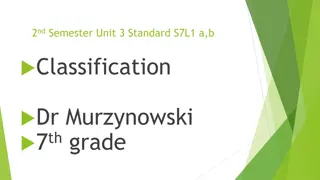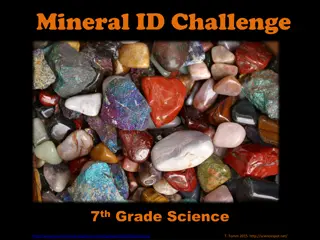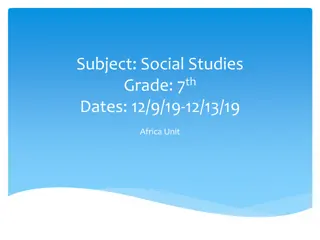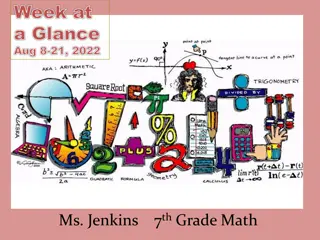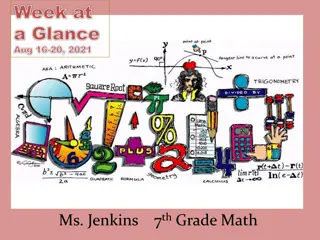March 2-6: 7th Grade Social Studies Week
This week at a glance for 7th-grade Social Studies covers various economic systems and trade practices in different regions. Topics include analyzing economic systems, benefits of voluntary trade, types of trade barriers, international trade, factors influencing economic growth, and more.
Download Presentation

Please find below an Image/Link to download the presentation.
The content on the website is provided AS IS for your information and personal use only. It may not be sold, licensed, or shared on other websites without obtaining consent from the author.If you encounter any issues during the download, it is possible that the publisher has removed the file from their server.
You are allowed to download the files provided on this website for personal or commercial use, subject to the condition that they are used lawfully. All files are the property of their respective owners.
The content on the website is provided AS IS for your information and personal use only. It may not be sold, licensed, or shared on other websites without obtaining consent from the author.
E N D
Presentation Transcript
Week at a Glance March 2 -6 Mr. Johnson 7th Grade Social Studies
Dear Parents, This week at a glance (WAG) is designed to give parents a brief idea of what their child is learning at school. It will have the subject standards (Georgia Standards of Excellence), the main topics covered, and some sample problems with links to videos and worksheets. We encourage parents and students to review this presentation together and to stay informed on the weekly learning objectives.
SS7E1 Analyze different economic systems. a. Compare how traditional, command, and market economies answer the economic questions of 1-what to produce, 2-how to produce, and 3-for whom to produce. b. Explain that countries have a mixed economic system located on a continuum between pure market and pure command. c. Compare and contrast the economic systems in South Africa, Nigeria, and Kenya. SS7E2 Explain how voluntary trade benefits buyers and sellers in Africa. a. Explain how specialization encourages trade between countries. b. Compare and contrast different types of trade barriers, such as tariffs, quotas, and embargoes. c. Explain why international trade requires a system for exchanging currencies between nations.
SS7E4 Analyze different economic systems. a. Compare how traditional, command, and market economies answer the economic questions of 1-what to produce, 2-how to produce, and 3-for whom to produce. b. Explain that countries have a mixed economic system located on a continuum between pure market and pure command. c. Compare and contrast the economic systems in Israel, Saudi Arabia, and Turkey. SS7E5 Explain how voluntary trade benefits buyers and sellers in Southwest Asia (Middle East). a. Explain how specialization encourages trade between countries. b. Compare and contrast different types of trade barriers, such as tariffs, quotas, and embargoes. c. Explain why international trade requires a system for exchanging currencies between nations. d. Explain the primary function of the Organization of Petroleum Exporting Countries (OPEC). SS7E6 Describe factors that influence economic growth and examine their presence or absence in Israel, Saudi Arabia, and Turkey. a. Evaluate how literacy rates affect the standard of living. b. Explain the relationship between investment in human capital (education and training) and gross domestic product (GDP per capita). c. Explain the relationship between investment in capital goods (factories, machinery, and technology) and gross domestic product (GDP per capita). d. Explain how the distribution of oil has affected the development of Southwest Asia (Middle East). e. Describe the role of entrepreneurship.
SS7E7 Analyze different economic systems. a. Compare how traditional, command, and market economies answer the economic questions of 1-what to produce, 2-how to produce, and 3-for whom to produce. b. Explain that countries have a mixed economic system located on a continuum between pure market and pure command. c. Compare and contrast the economic systems in China, India, Japan, North Korea, and South Korea. SS7E8 Explain how voluntary trade benefits buyers and sellers in Southern and Eastern Asia. a. Explain how specialization encourages trade between countries. b. Compare and contrast different types of trade barriers, such as tariffs, quotas, and embargoes. c. Explain why international trade requires a system for exchanging currencies between nations. SS7E9 Describe factors that influence economic growth and examine their presence or absence in China, India, Japan, South Korea and North Korea a. Evaluate how literacy rates affect the standard of living. b. Explain the relationship between investment in human capital (education and training) and gross domestic product (GDP per capita). c. Explain the relationship between investment in capital goods (factories, machinery, and technology) and gross domestic product (GDP per capita). d. Describe the role of natural resources in a country s economy. e. Describe the role of entrepreneurship. SS7E10 Understand that a basic principle of effective personal money management is to live within one s income. a. Understand that income is received from work and is limited. b. Understand that a budget is a tool to plan the spending and saving of income. c. Understand the reasons and benefits of saving. d. Understand the uses and costs of credit.
Videos Introduction to economics What is Economics?
Southern and Eastern Asia World Map #4 J F K 4 M B 5 3 1 H L C A 2 Pacific Ocean D G 6 E E 6
Southern and Eastern Asia World Map #4 J F K 4 M B 5 3 1 H L C A 2 Pacific Ocean D G 6 E E 6 1 2 3 4 5 6 A B C D China India Japan North Korea South Korea Vietnam Ganges River Yellow River Yangtze River Bay of Bengal E F G H J K L M Indian Ocean Sea of Japan South China Sea Yellow Sea Gobi Desert Taklimakan Desert Himalayan Mountains Korean Peninsula
10-28-19 World Map: #3 15 Political-physical map with physical features a 18 f a 14 12 13 u h g b L P 17 P e k 80 a 11 81 R d R R 16 M cc L 83 M N Q a. Locate on a world and regional political-physical map: Euphrates River, Jordan River, Tigris River, Suez Canal, Persian Gulf, Straight of Hormuz, Arabian Sea, and Red Sea. Afghanistan, Iran, Iraq, Israel, Kuwait, Saudi Arabia, Syria, Turkey, Gaza Strip, and West Bank. 82 T C N b. x 84 http://www.wetter-burman.com/cs/blank-world-map-for-children-printable-i1.gif World Map: Continents/ Oceans a. Locate on a world and regional political- physical map: Sahara, Sahel, savanna, tropical rain forest, Congo River, Niger River, Nile River, Lake Victoria, Great Rift Valley, Mt. Kilimanjaro, Atlas Mountains, and Kalahari Desert. B V S 2 4 7 a 9 8 85 Political-physical map C A 10 D D 3 80 81 E 83 6 1 82 84 F b. Locate on a world and regional political- physical map the countries of Democratic Republic of the Congo, Egypt, Kenya, Nigeria, South Africa, and Sudan. 85 5
World Map #2 http://www.wetter-burman.com/cs/blank-world-map-for-children-printable-i1.gif 15 D D f 11 k 13 12 h e g c d 14 a j 16 b 3 1 B F 8 E A A 10 4 10 C B 2 A 6 G # (Continents / region ) Letters (bodies of water) 7
Answer Key for World Map #2 1 2 3 4 5 6 7 8 9 10 North America (Canada,USA, Mexico) South America Europe Africa Asia (Russia, China, India) Australia Antarctica Southwest Asia China Southeast Asia A B C D E F G Pacific Ocean Atlantic Ocean Indian Ocean Arctic Ocean Gulf of Mexico Mediterranean Sea Southern Ocean 11 12 13 14 15 16 Afghanistan Iran Iraq Saudi Arabia Turkey Israel a b c d e f g h j k Arabian sea Red sea Straight of Hormuz Persian Gulf Suez Canal Tigris River Jordan River Euphrates River Gaza Strip Mediterranean Sea









